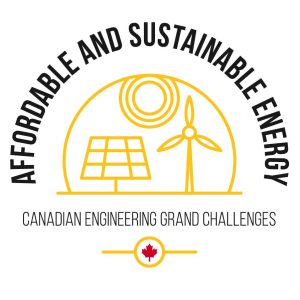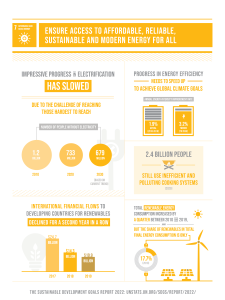CEGC 2: Access to Affordable, Reliable, and Sustainable Energy

Connection to the United Nations Sustainable Development Goals
| Affordable energy helps to reduce the financial strain placed on low-income populations | Affordable energy supports opportunities for all | ||
| Temperature control provided by energy helps to keep people safe in extreme climates | Clean energy reduces the greenhouse gas emissions produced from the energy sector | ||
| Affordable and clean energy increases access, and aims to increases the share of renewable energy and the rate of improvement in energy efficiency | Reduction of greenhouse gas emissions by clean energy assists in reducing human impact on the climate |
What is the Canadian Engineering Grand Challenge Statement?
The challenge for affordable and sustainable energy is to sustain growing populations and ensure livelihood of future generations, where future energy systems will be clean, safe, reliable, affordable and accessible (EDC-DDIC, 2022).
High Level Overview of the Canadian Engineering Grand Challenge
Access to energy is a necessity to thrive in the modern world. Energy is used to provide light, heat, and cooling, along with powering the many different appliances and electronics that require a constant supply of energy to function. Canadians consume more energy per capita than any other country in the world. There is no question of the importance of energy in everyday life, and it plays a significant role in the Canadian economy as well. Due to the significant energy consumption, there is a large demand that is primarily filled by Canadian industry. This reliance and emphasis on energy production and consumption creates a responsibility for Canada’s energy sector to be both sustainable and equitable. Currently, the most significant sources of Canada’s energy are crude oil and natural gas. Renewable energy sources make up a small fraction of Canada’s total energy production. Additionally, the lack of sufficient energy storage leads to occasional wasted energy and profit losses due to overproduction. All of these challenges and more await the engineers who will go on to make the world’s energy supply more affordable, reliable, and sustainable.
Example Connection to a Sustainable Development Goal
CEGC 2: Access to Affordable, Reliable, and Sustainable Energy maps to several Sustainable Development Goals, where an example of one of the connections is to SDG 7 – Affordable and Clean Energy, which has a goal to “Ensure access to affordable, reliable, sustainable and modern energy for all” (United Nations, 2023).
Figure: Infographic on Sustainable Development Goal 7 (United Nations, 2023)
Keywords: sustainable energy, energy access, low carbon footprint, decarbonization, fossil fuels, alternative fuels
Status of the Challenge Globally
Access to energy across the world’s cities and communities is still not established. Many locations across the globe either lack energy access altogether or depend on unreliable systems that may be expensive or harmful to the environment.
Status of the Challenge in Canada
Economic Impact
Energy at its core is a tool, a valuable commodity that allows access to a multitude of conveniences. The production and consumption of energy plays a vital role on the Canadian economy. In 2020, 8.1% of the Canadian GDP was comprised of direct and indirect energy sales (CEGC document, n.d.). Furthermore, in 2020 more than 845,500 Canadians had the energy industry to thank for their employment (CEGC document, n.d.).
Societal Impact
Canada needs energy. It allows for many conveniences and securities that would be otherwise inaccessible. In the summer, we use it to keep cool. In the winter, we depend on energy to heat our homes. Canadians consume more energy per-capita than any other country in the world and consumes about five times the energy of the national average (EDC-DDIC, 2022). Despite this, as of July 2022, more than 280 communities and 200,000 people in Canada are not connected to the North American electrical grid and natural gas pipeline systems and lack access to a safe, sustainable, and affordable supply (Government of Canada, C. E. R., 2020). These communities are largely in remote locations in Canada and rely on either diesel-fired generation, or smaller local electrical grids based on hydro or trucked in liquified natural gas (Government of Canada, C. E. R., 2020). All of these options are expensive and limit the reliability of access to energy. To overcome this, engineers need to come up with new ways to either connect these communities to the larger electrical grid or help them become more self-sustainable.
Environmental Impact
Energy, despite the prosperity it brings, has its drawbacks when it is fossil-fuel based. In 2021, 78% of global greenhouse gas emissions came from the production and consumption of energy, and this number is elevated to 81% in Canada (CEGC document, n.d.). There are numerous challenges in switching to a lower-carbon energy system; however, this presents Canada with the opportunity to become a global leader in developing and embracing innovative and sustainable technologies in the energy sector. Canada has committed to reducing its greenhouse gas emissions by 40-45% below 2005 levels by 2030 (Government of Canada, C. E. R., 2020). With this commitment, Canadian engineers have all the more incentive to pioneer new technologies to protect the environment.
Roadblocks to Success
Creating access to affordable and sustainable energy would not be considered one of the CEGC if it were a simple task. The size of Canada is a significant obstacle in delivering energy to all Canadians. Developing electrical infrastructure to span the entirety of Canada is currently a difficult and financially infeasible task. Some small communities in Canada are not accessible year-round or can only be accessed by plane on a regular basis. While access remains limited, it does not make logistical sense to connect these communities to the larger grid, and they will instead need improvements to their individual systems. Many of these remote locations also face harsher climate conditions, especially during the winter. Within isolated energy systems, renewable technologies such as solar power can be less rewarding as some communities have limited access to sunlight for much of the year. Lack of energy storage is another area in need of improvement in the push towards sustainable energy. Renewable electricity sources such as solar and wind power produce intermittent outputs based on the environmental conditions at the time. If a surge in production happens during a period of low power demand, a grid may need to sell its energy at a negative price to other jurisdictions.
Strategies to Meet 2030 Targets
To address the challenge of supplying safe, reliable, affordable, and accessible energy, Engineering Deans Canada have identified the following strategies (EDC-DDIC, 2022):
- Identifying and investing in high quality and promising energy technologies using rigorous and standardized metrics
- Funding research and development in promising energy technologies throughout the entire research and development chain, especially pilot scale and first-of-a- kind ventures
- Investing in cleaner methods of extracting, processing and utilizing hydrocarbon fuels, including reduced consumption of these fuels.
- Taking deliberate steps to make government aware of the identified challenges and offer cost-effective solutions/alternatives for government decisions and policies. For example, strongly advocate against urban sprawl.
References
- CEGC-document-eng-may 2022.PDF. ENG. (n.d.). Retrieved February 28, 2023, from https://ecampusontario.pressbooks.pub/app/uploads/sites/2928/2023/02/CEGC-document-ENG-May-2022.pdf
- EDC-DDIC. (2022, May 6). Canadian Engineering Grand Challenges (2020-2030). Engineering Deans Canada. Retrieved February 23, 2023, from https://engineeringdeans.ca/en/canadian-engineering-grand-challenges-2020-2030-inspiring-action-to-improve-life-for-canadians-and-the-world/
- Government of Canada, C. E. R. (2020, September 29). Canada energy regulator / Régie de l’énergie du Canada. CER. Retrieved February 28, 2023, from https://www.cer-rec.gc.ca/en/data-analysis/energy-markets/archive/energy-use-canada-north-facts-2011/energy-use-in-canadas-north-overview-yukon-northwest-territories-nunavut-energy-facts.html
- United Nations (2023). The 17 Goals, United Nations Department of Economic and Social Affairs, Sustainable Development. Retrieved February 27, 2023, from https://sdgs.un.org/goals

